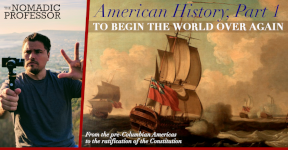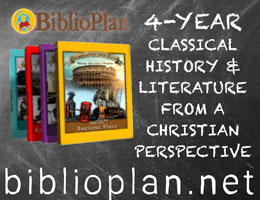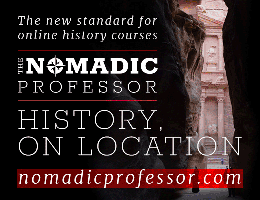The Nomadic Professor plans to produce a series of courses covering American, world, and Asian history, as well as Western civilization, with four semester-long courses for each. Only the first three courses for American history are available as of January 2024, but I couldn’t wait to tell you about them!
The courses are being created by Dr. William Jackson and Nate Noorlander who have been teaching history at the university and high school levels, respectively. Jackson creates the videos and writes the text based on his years of teaching at the university level. Most of the videos are filmed on his travels around the world—thus the name of the series, The Nomadic Professor. You can watch some of Jackson’s videos on YouTube that are presented in the same fashion as those throughout the courses. Noorlander presents "document lessons" that teach students how to evaluate information from different sources, including primary source documents. Noorlander is also responsible for the supporting resources: handouts, guided notes, quizzes, and course documentation.
While these are survey courses, they discuss particular topics in depth rather than trying to cover every important event. These courses are designed to help students think like a historian. I especially appreciate that both Jackson and Noorlander often teach by presenting opposing viewpoints on a topic without revealing their own biases.
The idea is that students will complete two courses per year, and this will be the same arrangement for the other courses. I will concentrate on American History, Part 1, the first course.
The American (U.S.) history courses will follow this sequence:
Part 1: Pre-Columbian Americas to the ratification of the U.S. Constitution
Part 2: Washington’s presidency to the end of Reconstruction
Part 3: Custer and Crazy Horse to Hiroshima and Nagasaki
Part 4: Cold War to the War on Terror
New units are being completed at the rate of about one every five weeks.
How the Courses Work
These online courses are laid out online in a step-by-step fashion that is easy to follow. That’s important because these complex courses have several elements: text, images, videos, vocabulary words, quizzes, documents to read, and assignments.
The first American History course has ten units, and each unit has an introduction followed by four to six lessons. The unit introductions start with timelines, maps, and images that help students think about topics within the context of a particular time and place. The introduction then lists key ideas for the unit. The key ideas are stressed in the introduction, within the lesson material, and in a summary at the end of the lesson. Similarly, “Structure Terms”—words or phrases students need to learn—are introduced in the unit introduction then taught in each lesson and reinforced with practice activities. This way students know what they are expected to learn, and the key ideas are reinforced by repetition.
Three to five lessons within each unit are taught by Jackson, and a document lesson (described below) is presented by Noorlander. When students are ready to start a lesson, they need to first print out the Guided Notes that are linked at the beginning of the lesson. These vary from lesson to lesson, but they typically look like graphic organizers or have comprehension questions. Students can fill these in either after or while they watch the videos and read the lesson material. A key for the Guided Notes is linked at the end of each lesson, including the document lessons.
Jackson's lessons are a combination of online videos and text. Rather than starting each section of the text with a bland title such as "The First Colonies," each section of text has a question as the heading. This helps students focus their attention on how the material answers each question. There are occasional illustrations with the text. Audio recordings of the text material are available for those who would like to listen as they follow along or those who would like to listen rather than read. Students can listen online or download the audio to another device.
Videos are interspersed among the sections of text. Students work through the material in order as presented. The number of video presentations is greater for some topics than others, probably based on the availability of appropriate locales and the practicality of filming there. There are a number of onsite video lessons for the first unit, which is about the pre-Columbian Americas, and only a few for the second unit on explorers. Apparently, there were plenty of accessible sites for filming about pre-Columbian civilizations such as the mound cities and Ancestral Puebloan ruins in the United States and Incan sites in South America. In most of these videos, Jackson walks through a historical site, talking as he goes. These videos generally show the location on a map on a sidebar on the right side of the screen. Sometimes, the screen zooms in with Google Earth® so students get a better sense of the location. Occasionally, the videos are of Jackson’s classroom lectures, illustrated with a few photos or other illustrations.
Each lesson has "Structure" terms at the end in three forms for study. The first has the terms followed by a list of definitions for students to match. The second is a printable set of flashcards, and the third is a set of online Quizlet flashcards.
Each section ends with an online quiz. Results are emailed to either the student or parent immediately after each quiz. The program marks which answers are correct and incorrect, and it adds an explanation for incorrect answers. The program does not retain scores, so you’ll need to keep track of them yourself if you want to preserve them. The quizzes are a helpful assessment tool, but if students are completing the Guided Notes as they work through each lesson (and not cheating by looking at the answer keys), and they are completing the writing for the document lessons, you should have sufficient material to assess progress. The printable course documents include a rubric for grading the guided notes and a chart showing how to weigh the guided notes, quizzes, document lessons, and Structure terms.
Document Lessons
The document lesson at the end of each unit adds another dimension to each course. With Guided Notes pages in hand, students watch a presentation by Nate Noorlander that teaches students critical thinking skills for evaluating information. They work through a few documents for each lesson, such as primary source documents, excerpts from textbooks that express a variety of perspectives, and images of historical artifacts. For example, for a question relating to Christopher Columbus, the document lesson has students compare and contrast excerpts from three books. Two of these are written from dramatically different points of view—A People’s History of the United States by Howard Zinn and A Patriot’s History of the United States by Larry Schweikart and Michael Allen. A third resource, Columbus: The Four Voyages by Laurence Bergreen, is more neutral in tone than the other two resources.
In another example, Lesson 5.5 poses the question, “Why do interpretations of historical events (and people) change over time?” This lesson uses Bacon’s Rebellion (in 1676) as the topic for investigation. It presents six sources: two historical letters, a poem written in that era, an image from around 1900 that illustrated the event after the fact, and two accounts from history books written 320 to 325 years later.
The document lessons often address "big ideas" that students should think about, like that in Lesson 5.5. The third U.S. History course has a document lesson related to the fast-growing wealth disparity at the end of the nineteenth century and the challenges to capitalism that resulted, mirroring exactly what is going on in our modern economy.
There are about 10 to 15 pages of Guided Notes for each document lesson, so these are substantial lessons that will take some time to complete. Strategies for working through these lessons are thoroughly explained in videos. Students can share their responses with an online community, which could be very motivational and interesting if enough students participate.
The document lessons in the first course build skills sequentially, and they lay the groundwork for work in the next American history course. The final assignment in this course has students learn how to come up with a good research question by analyzing many examples. In the next course, students will write a research paper. The plan is that for each group of four courses, students will learn how to research and analyze information in the first course, and then write a researched essay for each of the next three courses. The courses will teach students how to do scholarly research and writing at the college level. Students can't pick and choose which document lessons to complete. They need to either do all of them or skip them entirely.
The course material without the document lessons is excellent, but the document lessons are so worthwhile that I would urge you to try to use them. The document lessons lend themselves particularly well to a group class setting where students can compare their opinions, but that setting isn't required.
Three Options for Students with Different Goals
These are survey courses that were designed for high school students, with three different options: full, standard, and content-only. Completion of the four American history courses over two years following the full course schedule should prepare students well for the Advanced Placement U.S. History test and the CLEP U.S. History I and II tests. As the authors explain in their scope and sequence for American History Parts 1-4, “This is an interdisciplinary course, with rigorous training in various social studies and language arts supplements. Homeschool families who plan to generate their own transcripts could include .5 credits for a range of other courses, including historical methods, college writing, logic and rhetoric, and American literature.” This would be in addition to one credit per year for history. (See the credits chart on their FAQ page.)
The full course option is what I have described. The standard course option has students skip four specified sections within the lessons, and the document lessons are optional. The content-only option is for students who want to learn the historical narrative but want to skip the lessons on “how to read, research, reason, and write like a historian.” For this option, students skip some supplemental handouts and use none of the document lessons. The authors show the options in terms of the number of sessions required for each: 200, 168, and 160, respectively.
Summary
These courses should appeal to anyone who wants students to both learn history and learn how to evaluate historical information, a type of learning that is useful in many other areas. On top of that, the course design is perfect for today’s students with its mix of video, audio, text, and written work.













